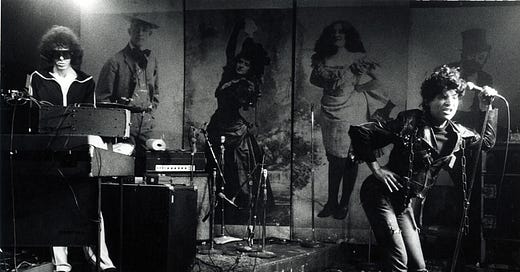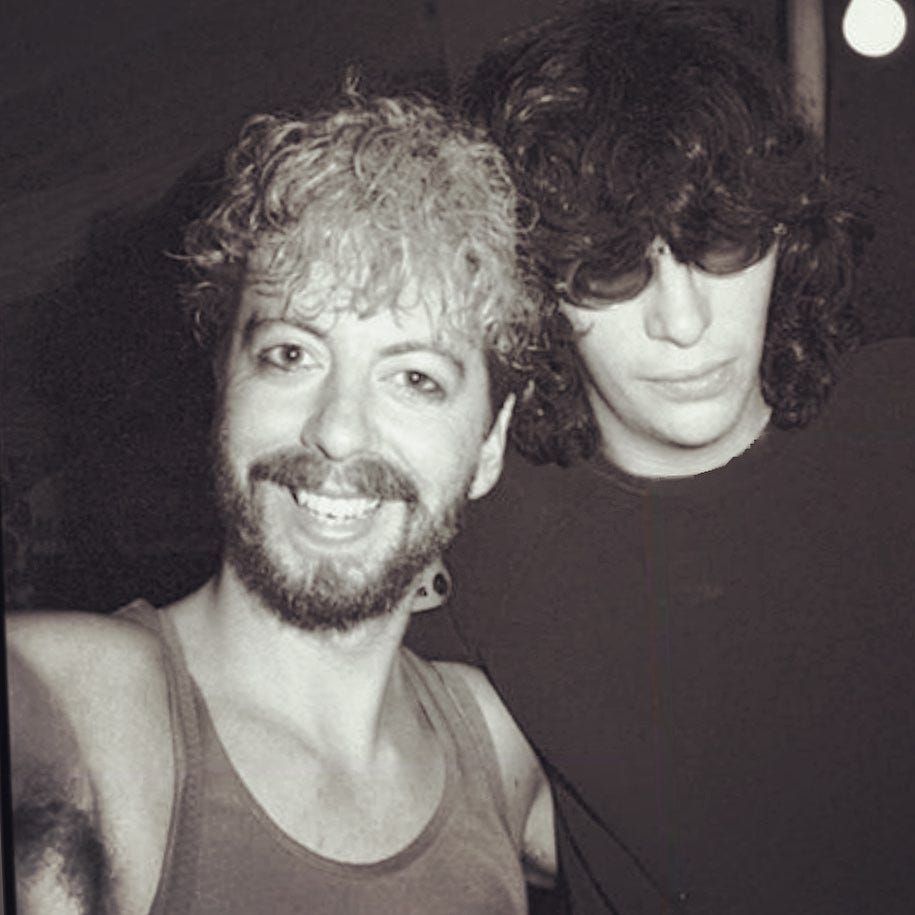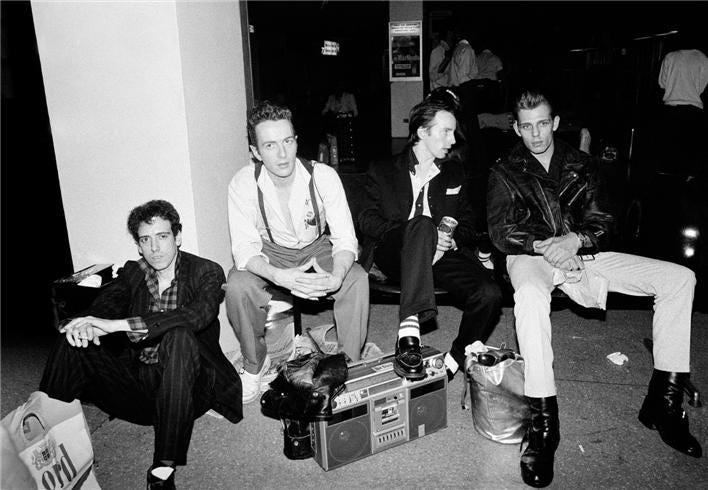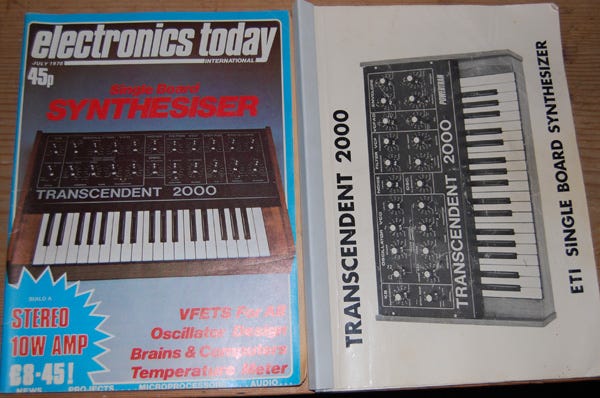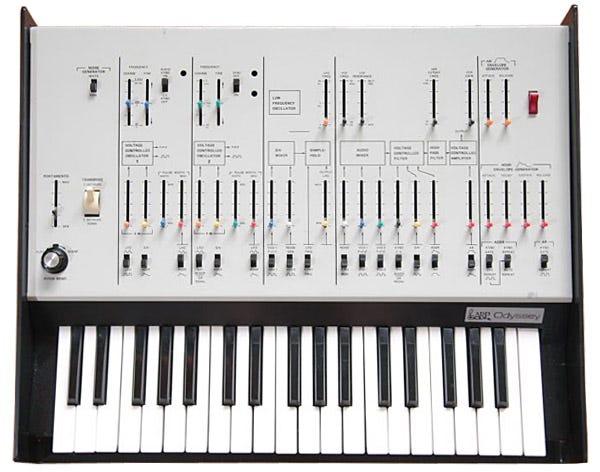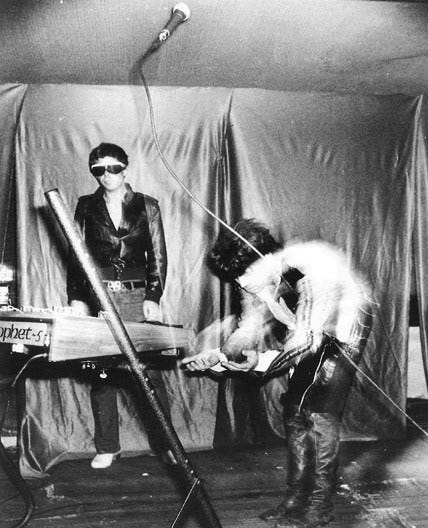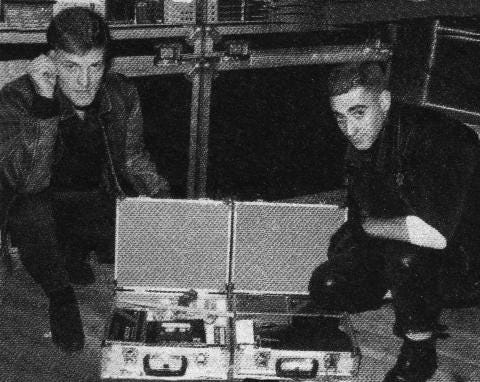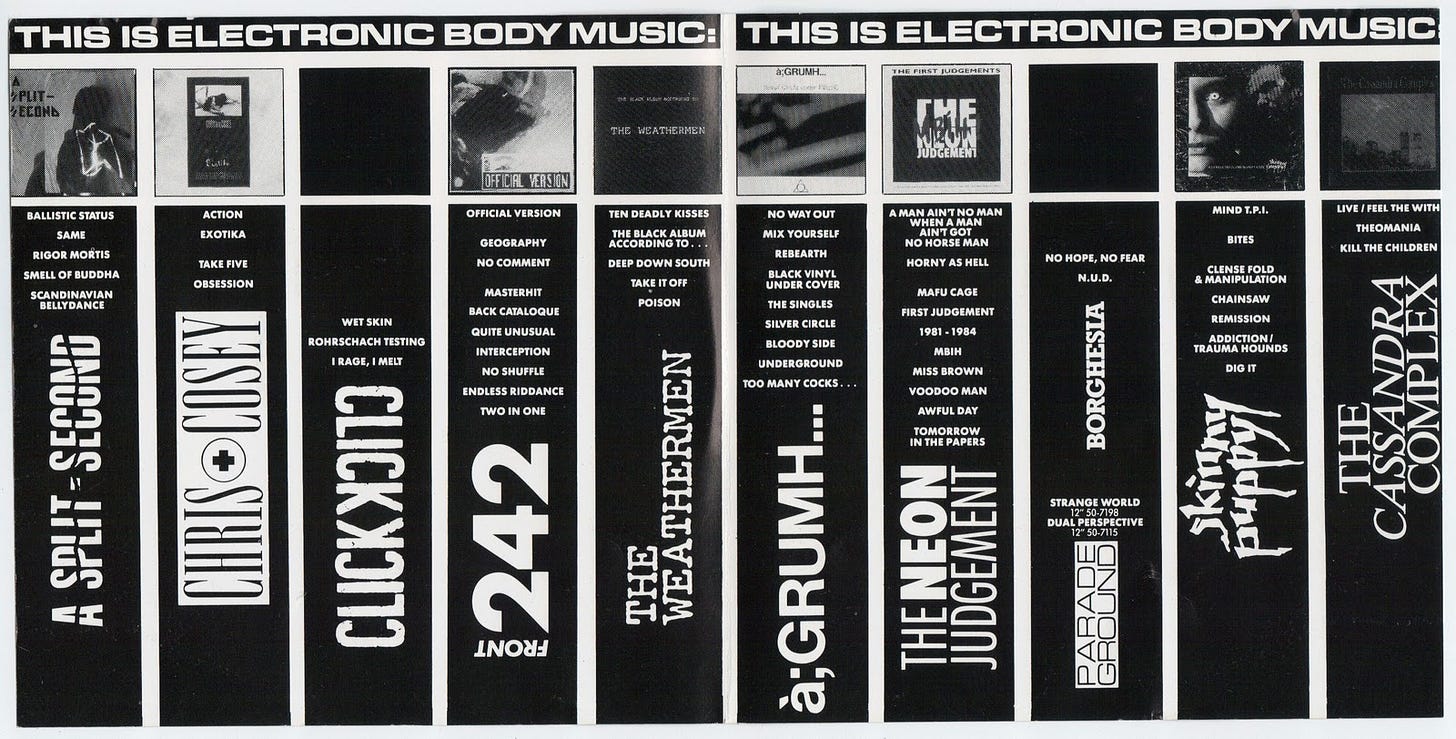The Invasion of Synthesizers in Punk!
These powerful electronic instruments came to stay in a scene that was run out and looking for new forms of expression.
“I do not understand that there are people who detest electronic music. I have come to say that synthesizers are very rightist instruments politically. On the contrary, they are the triumph of the theories that the punks launched in 1977. Right now, a good Casio is cheaper than a bad electric guitar. People who never played an instrument before will suddenly be able to pick up a Casio VLTone and they'll write and play their own songs."
-Pete Shelley, ex-Buzzcocks, 1983.
These new obscure, unknown machines embraced the spirit of Punk and came to complete the musical revolution initiated by it. But what can you do with a synthesizer? You can create your own sounds, conceive new dimensions without any restriction and draw your own vision. That´s why young musicians took the crude sounds and the energy of the seventies to a whole new level. Because Punk challenged the status quo of music with its spirit and anarchy of three chords and “Do It Yourself” attitude because PUNK is whatever you want to make it.
The Ramones -the band synonymous with punk rock- delivered us a ton of immortal hymns that spoke to a generation, choose in some occasions synthesizers to color their songs. For example, in “Something to Believe in” -from the album “Animal Boy”- released in May 1986, they used synthesized bells and strings (probably a Yamaha DX7, launched to the market in 1983).


Another example is “Too Tough to Die” album (1984), produced by Ed Stasium and Tommy Ramone. There are two songs in which there were some synthesizers involved. “Howling at the Moon” starts with a strident Commodore 64 sequence -the famous home computer released in 1982 by Commodore International-. Probably the reason why those electronic sounds were there is that Dave Stewart, English musician, and producer of the famous New Wave band Eurythmics, was also involved in the production of this particular song1. Jerry Harrison (Talking Heads) also appeared in the credits of that song, as well as, in “Chasing the Night”, he also came out as responsible for adding some synths to the mix.
Dave Stewart & Joey Ramone in the studio (1984)
The engineer of the anthem “Pet Semetary” Fernando Kral said to Sound on Sound magazine: "…We continued overdubbing through Friday night, including synth pads doubling the guitar in a higher register, as well as some percussion, gated handclaps, and Daniel's single-note guitar solo, using a Fender Twin in Studio 5 with the spring reverb. That was the kind of flourish that changed the track from sounding like traditional Ramones."
In April 1984, Joey expressed some controversial thoughts about the world of synthesizers: “In our position, we've always done well, but we just haven't had that hit yet that put us over the top. We always break even. The fact that we've never lost anyone's money, and the fact that we are a prestigious act - I mean, we started the whole thing. We're responsible for even the synthesizer bullshit, which is a revolution of what we started in '76.”

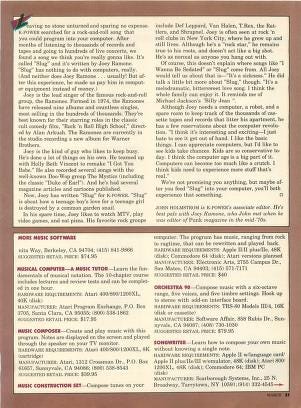
Also, Dee Dee Ramone (Dee Dee King) choose some odd and new sounds full of bass-and-synth drums to punk metal synth-pop, and so on in his first solo Rap album “Standing in the Spotlight” (1989). You can listen here!
In an interview for Red Bull Music Academy the band Blondie talked about their production and how they nailed the futuristic disco style. “They created their own sound from New York’s melting pot of punk, wave, reggae, and hip-hop, all shot through with Deborah Harry's cool soul.” Also, Chris Stein was asked about his work in the studio and he answered: “I sit there now and I do a lot of programming and I make a version of the song, somewhat, and then I send it to my producer, and he replaced some parts, and then we all got together later on in the process and replaced more parts. But at this point, every song has some of my little synthesizers and things on it that we started out with.” And Debbie Harry supported this answered and said: “Yeah, he comes up with some nice sounds.” Some of the gleaming and eclectic sounds that we listen to in this band were created by Farfisa Organ and the Polymoog synthesizer.
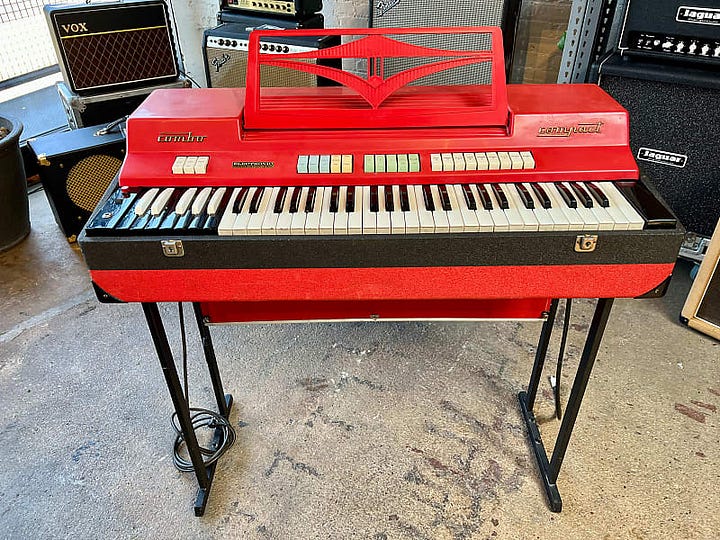
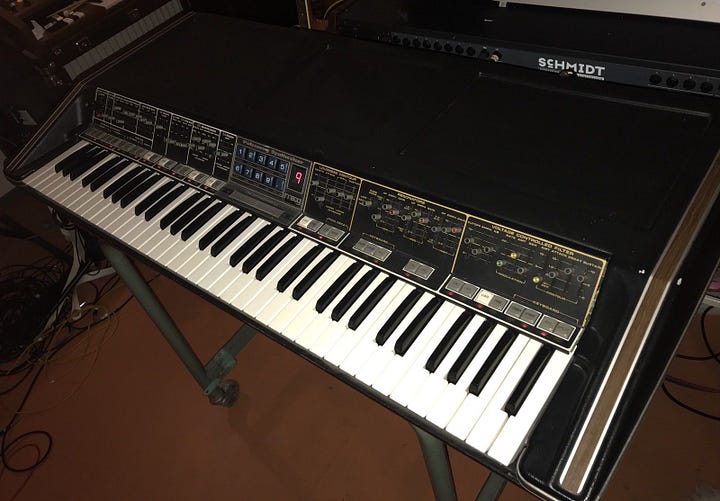
Also, they used a little gem called a Roland CR-78 Drum machine for “Heart of Glass” song, the first track recorded for their third album, Parallel Lines. (You can check out this machine in action in this documentary about the production of this record, and also you can listen to this brief intro).
Also, Blondie conversed with UK Magazine Uncut about the composition and production of this record: “…Was based on a three-year-old demo, it was painstakingly transformed with synth grooves inspired by Kraftwerk and Giorgio Moroder and given a Saturday Night Fever beat. It reached No 1 on both sides of the Atlantic and Blondie become the biggest band to come out of the New York punk scene… with a disco record.”
Stein remembered: “The Ramones made comments about us selling out.”(…) “But everybody at CBGB’s was pleased and amused that we had a hit. And jealous that they didn’t.”
Chris Stein said that Jimmy Destri, the keyboardist had a lot to do with how the record finally sounded. “It was Jimmy who brought in the drum machine and a synthesizer. Synchronizing them was a big deal at the time. It all had to be done manually, with every note and beat played in real-time rather than looped over. And on old disco tracks, the bass drum was always recorded separately, so Clem (Burke) had to pound away on a foot-pedal for three hours until they got a take they were happy with.” Clem also sentenced: “The key, radio-friendly songs were usually at the beginning of a record. ‘Heart Of Glass’ is buried on the second side of the album. We didn’t record it to be our big breakthrough. We had no idea. We were trying to sound like Kraftwerk.” Mike Chapman, their producer, remembered that when he asked Debbie at that time what was out there that was influencing her she said: “Donna Summer. I really liked Giorgio Moroder’s repetitive synthesized groove, too.” Two years later, Debbie collaborated with Giorgio as her producer on the song “Call Me”, released in 1980 for the movie “American Gigolo”.
The Clash also lived in a constant mutation and renewal. In each of their albums, it can be noticed the metamorphosis and the appearance of synthesizers in their projects. Let´s take a closer look!
In “Silicone on Sapphire”, a song from “Sandinista!” album released in 1980, the band experimented with psychedelic sounds like video games and synthesizers. Also, in “Version Pardner” they played with echo, drums, bass, piano, and synths but also various whistle sounds, a lot of dub, and much reverb applied to everything.
The song “This is Radio Clash” of "Revolution Rock"2 is a whole tribute to New York rap acts, such as The Sugarhill Gang and Grandmaster Flash and the Furious Five. Strummer's high-pitched laugh at the start of the song was directly inspired by Grandmaster Flash's "The Message." Also, there are strong synthesizers and amped-up funk bass.
Another example can be found in their last album “Cut the crap”, released in 1985 and categorized by many as a post-punk, electropunk album. Lisa Robinson, talked to Joe Strummer about the departure of Mick Jones and she asked: “What did he want to do, play a synthesizer or something?” Strummer answered: “He thought maybe we could be an electro-boogie group, I think. He had a Roland guitar synthesizer, and I think he preferred to be twiddling the knobs on the synth. He’d plug the guitar into the synth, but what he ended up liking to do best was holding a note on the guitar and then playing with the synthesizer, like, twiddling knobs to make it go [makes synthesizer noises], like, sound like a Volkswagen or a symphony or whatever, it had a lot of knobs, this thing. I thought that was kind of fun for five minutes, but after he had his fun, I wanted him to play the guitar. I wanted him to play the guitar, the audience wanted him to play guitar, and Paul wanted him to play the guitar, so why didn’t he play the guitar? No, it was too passe, it was non-artistic, geniuses like him didn’t have to stoop so low as to play a punky chord full of roaring distortion, which is my favorite guitar sound.”
Another band that took the risk was Talking Heads, although they are not strictly punks, they are part of the movement and what´s coming… New Wave. Jerry Harrison used DX7, Prophet 5, and Emulator ll to contribute more to developing the band´s sound color. He also worked with The Ramones, as mentioned before.
Transcendent 2000 is a synthesizer designed in the U.K. by Tim Orr in the 1970s and published as a self-build project in Electronic Today International magazine in July of 1978. It was the first Synth for a lot of British musicians like Joy Division -because it was very cheap-. A perfect example of “Do It Yourself”.
Another band that used electronic sounds was The Buzzcocks -the ones who are forever associated with the expeditious, pop-punk template which they helped to create-. The albums “ Another Music in a Different Kitchen” (1978), “ Love Bites” (1978), and “A Different Kind of Tension” (1979) all were produced by the peculiar and extraordinary Martin Rushent (also producer of Generation X, The stranglers, The Human League and Pete Shelley solo career).
But lead singer and guitarist of The Buzzcocks, Pete Shelley, also contributed unquestionably to several styles of synthesizer music. Recorded in 1974 -before the Buzzcocks’ formation- but not released until 1980, his debut solo album “Sky Yen” combined the relaxing vibes of Tangerine Dream with the world of Lou Reed’s Metal Machine Music (A sequel of sorts, Cinema Music and Wallpaper Sounds, recorded in 1976, was released in 2016)
Following the Buzzcocks’ breakup in 1981, Shelley’s solo career began that same year with a pair of synth-dominated singles like “Homosapien,” which was an instant hit.
These are wild ones too: the synth-punk sound of “The Screamers”
The Screamers were an American electropunk band founded in 1975.3 They used synthesizers, keyboards, and drums but no guitars. This underground noisy combo was pictured by the LA Punk Fanzine Slash magazine in the late '70s as “the one and only group in this galaxy to have done away with guitars and other lame gimmicks”. They Combined influences from such diverse figures as the Bay City Rollers, Denny Martin, and Brian Eno. Tommy Gear, the keyboardist, played an ARP Odyssey, the first duophonic synthesizer better known as the most “punker” synthesizer in the world.
Also, the Magazine portrayed them as the future and advised us to learn about Tomata, Gear, K.K., and David, “pioneers of what one of them calls the NOUVEAU VAGUE SOUND.” This group also were fans of Ramones “I first saw em standing in the audience at the Ramones”.
In Synapse Magazine, (May/June 1978) they stated in a very clever way the transition that the music was going through. Gear said: “We're in a period of transition in a sense; barriers are being blurred or being redefined--it puts everything in a jumble. I think that's why punk music came along when it did, is because of the redefinition of categories.” And Tomata recalled: “First they called us punk, then they called us art, now they call us techno-punk.” Gear added: “Popular music has suffered what I refer to as a tyranny of guitars. It would be like it classical music if they were to feature one instrument alone . . . The synthesizer as you know is a very versatile instrument, but every time I see it, it's used just as a mere sound effect device.” A unique combination of avant-garde, diversion, and action. Let´s listen to The Scremears and their “122 Hours Of Fear “(Live at the Target)
By the end of the seventies, the turbulent energy charge of punk had already been consumed and the post-punk environment was full of experimentation (some of them exponents of the new wave). Synths had begun to integrate the conventional current of rock. In a sense, its entrance was the inevitable evolution because it was cheap, convenient, and above all things, relatively easy to learn to play. It began selling in 1964 but had no acceptance in the field of rock and pop. The first impact was in 1969 when The Beatles included some synth sounds in the "Abbey Road" album. The first years of the decade witnessed the true innovation of the synthesizer in the music scene, especially in the music of Suicide, Can, and Kraftwerk. The latter band and his 4th album "Autobahn" had a great influence on the music of the late '70s and '80s. While Bowie and Moroder admitted their debt, the hypnotic drive of Kraftwerk was the blueprint for electropop, hip-hop, and house music.

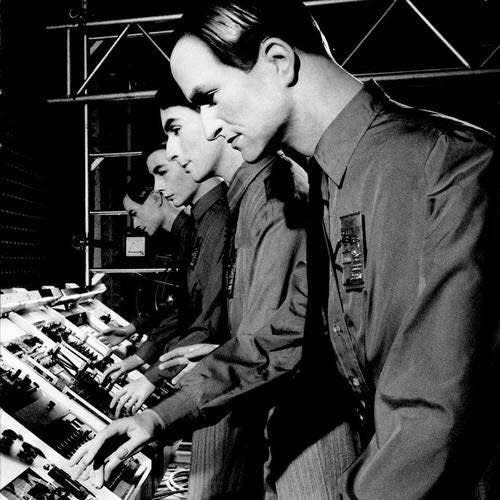
At first, Suicide and Kraftwerk were the catalysts of the many bands that emerged from the first post-punk confusion. Very significant were the words of Ralf Hütter, (Kraftwerk), when in 1977 he said: 'The guitar is a relic of the Middle Ages and the synthesizer is the instrument of the future.'
Already in 1978, electronic groups appeared that caused a quite positive impression in the scene, like Cabaret Voltaire, Dalek I (Love You), Deutsche Amerikanische Freundschaft (DAF), Ultravox, and Tubeway Army (of Gary Numan), among others. Undeniably, punk purists were hesitant about these bands but the truth was some of them were rationalizing the possibilities of electronic pop music. In the two years that followed, Human League, Japan, Fad Gadget, OMD, Soft Cell, and Blancmange emerged.
In the early 80´s Martin Gore (from Depeche Mode) said about the context that existed at the end of the '70s. "We were learning at full speed" (...) "We paid a lot of attention to what was happening outside (...) for us, the synthesizer It was a punk instrument because it was a new thing, its potential seemed to have no limits, it really gave us the chance to explore." Dave Gahan (D.M.) said, "We were always futurists, for me. The Futurists were the extension of punk rock, we never had anything to do with the neo-romantics. But they call us whatever they want: ultra-pop, futurists, disco thing, but no neo-romantics", by Daniel Decaux, “Depeche Mode, La Historia Ilustrada del Grupo Creador del Tecno Pop”.
Suicide, pioneers of a new sound:
Suicide was an American electronic protopunk musical duo, intermittently active since 1971 formed by vocalist Alan Vega and Martin Rev on synthesizers and drum machines. They had it all, the originality and the pure craziness of the punk attitude. They defined the US punk scene centered around Max’s Kansas City and CBGB’s, who along with New York Dolls, The Ramones, Blondie, Television, and Talking Heads changed the game's rules. The name Suicide was inspired by Satan Suicide, an issue of Vega’s favorite comic book, Ghost Rider.
Their second show was entitled Punk Music Mass, which is said to have been the first time a band used the word “Punk” in an official context to describe their music.
Alan and Martin did an interview for the show “All Tomorrow's Parties - Soft Focus - Episode 7” and talked about their art and conception of music:
Alan Vega: “ I was at art and electronic music at that time and we both do we saw that we saw it, man it was so obvious we didn´t need the drum nor the guitar anymore, we´re just like, Hey! Let´s move this on to another place”. Besides, they said, it was a very important economic aspect, they couldn´t afford the rehearsals, among other things, that a traditional band needs. But the main thing was there wasn´t any precedent in the electronic scenario and also the band recalled: “We felt we were the only band” in that time doing that kind of stuff.
Vega brought to mind: “We came at least two years before the Dolls maybe more…” “We played for hours in this loft in Manhattan and made tapes and then listened back after hours, and see if we can sing or not, because there was no way to judge it, there´s nothing to judge it…” (…) “We knew, I loved it and it was great but at the same time, though we have to be insane.” You can watch it here!
Alan loved extremes, rock and roll and The Stooges, La Monte Young (considered the first minimalist), the beat-driven electronic art of Silver Apples (American Psychedelic Electronic Group). Although the band didn´t release its debut album until 1977, they spent years refining their unique sound because it was so radical that even in the middle of punk´s moment, the group didn't get to record an LP until that year. The 10-minute-plus “Frankie Teardrop” was the centerpiece of their debut. At the time, their electronic gear included little more than a beaten-up Farfisa organ, a primitive drum machine, some Electro-Harmonix distortion pedals, and a transistor radio good for ambient white noise and feedback generation. Suicide recorded with producer Craig Leon, a 25-year-old who helped create the debut albums of Blondie and Ramones. Also, he worked with Talking Heads.
Leon had the idea to run Vega’s voice, along with some of Rev’s keyboards, through an early Eventide digital delay pushed to the distortion point, a technique he’d learned from Jamaican producer Lee Perry during a Bob Marley session. Here is a video of Leon in action, he remembers his work with Ramones and he also explains how to use a MOOG in the recording process and explain how to shape a sound, take a glimpse!
Talking about the early years of the band, Vega said to Igloo Magazine, “We started out with a ten-dollar Japanese keyboard that Marty found somewhere. We could hardly get any sound out of it so we started introducing, was it an Electro Harmonix thing with bass boosters and treble boosters? The keyboard could be lined up with 5 or 6 of these things and that would jack up the sound because we almost couldn’t get any sound out of this thing. It was a necessity thing. Out came this incredible rush of sound that no-one has ever heard before or since. The sound was created out of necessity and we ran with it, man.” And also he remembered: “Marty and I, we were both hearing electronics. In the 60s I was already fool around with just noise, just radio static and shit. It´s our musical taste. We like to hear noise, you know? We got a Farfisa after that? (Asked Alan to Martin). “It was actually a Wurlitzer and eventually we got the Farfisa, which was a big step. A friend of ours sold that to me and that what´s we did the first album on that drum machines about a year before the first album.”, answered Rev.
By 1975, Rev had acquired a 1950s drum machine4 which expanded their musical possibilities exponentially. Vega had got hold of a two-track tape recorder, which enabled Suicide to make their first demos. Meanwhile, the New York music scene was being transformed by a wave of new bands (The Ramones, Television, the Patti Smith Group, Blondie, and Talking Heads) performing regularly at CBGB. One by one, those bands were signed by major record labels, while Suicide continued to be conspicuously overlooked. Indeed, Craig Leon recalled: “There were no sophisticated synths or anything, it was just whatever he found!”
The divergent and kooky amalgam of patch-up components that made up Rev´s “Instrument” –as it´s credited on the first album cover- played a major part in the album´s eccentric sound. Anticipating new wave, no wave, synth-pop, industrial, electro, and other genres, it was in its way far more radical and foundational than the punk bands it preceded.
Their Legacy:
Before synthesizers were cool and bands use them, Suicide was living the adventure with them, before the punk word became eminent, Suicide used it in a pamphlet.
They had a powerful mash, a vehement, raging punk-style attitude, and a powerful rockabilly way of singing together. Their spirit has been titled as many things, from proto-punk to synth-punk but what matters is that they did something no one else did at that time. Alan Vega created, together with Martin Rev -in Suicide first and later with his solo career-, a music style that gave birth to post-punk when it was still proto-punk. I mean, it was punk with synthesizers, it was a voice that came closer to Elvis than to anything else. "We were talking about the suicide of society, especially of American society. New York was collapsing, and Vietnam was happening. The name Suicide said it all for us", explained Vega on the name of the band.
They never were widely popular amongst the general public but they were and still are highly influential5. Critic Wilson Neate writes that Suicide "would prove as influential as The Clash. Listening to their self-titled 1977 debut from the vantage point of late 2002, it's all so obvious: the synthpop, techno, and industrial dance sounds of the '80s and '90s, and now the new New Wave of electroclash, all gesture back to that foundational album."
Thurston Moore of Sonic Youth told Red Bull Music Academy: “They were like electronic music terrorists on stage”(…) “It was an assault on the audience physically and aurally. It was incredible.” Lou Reed once said about “Frankie Teardrop”, he wished he´s written it. Henry Rollins, Black Flag singer, describes his reaction when he listened to a Suicide record for the first time: “It´s one voice and one synthesizer. We had no idea what we were in for. The single more intense song I´ve ever heard in my life is contained on this record it´s called Frankie Teardrop. Try it, it´s easily the most intense song you´ll ever hear it. It blew our young minds so substantially that all we could do is laugh and make fun of the record for the rest of the night because it made us so nervous I didn´t play the record again for weeks, I just couldn´t face it, it was too much. He was too different it blew my mind too hard but eventually I came back to it and it became one of the most important albums of my life(…) The first Suicide album is one of the hugest game-changing mind-altering records that I own.”
They were outsiders even in an embryonic New York Punk scene. Alan and Rev were too provocateurs. They ate traditional rock culture and they regurgitated an outlandish but fantastic future by blowing all the known and letting us meet the doorway of the unknown full of promises.
They promoted the synthesizer not as an inaccessible, out-of-reach ornamentation for music experts, instead, they convinced us that it was for everyone. Indeed, they helped to create a new image of this instrument as a more reachable and uncomplicated play that can create whole alternate realities with the flip of a switch.
Suicide became one of the most influential bands that ever existed. It’s Kraftwerk who gets the flattery and prestigious for being so ahead of his time and of course, they are the parents of electronic music and inspired a whole generation of pop and rock bands to use synthesizers. But Suicide also deserves the credit, they were equally influential on the industrial music and – in my opinion- techno scenes that came after.
You can find more information in the book In Dream Baby Dream: Suicide A New York Story, by Kris Needs
Rebel hearts & machine dreams
“The Sex Pistols sang ‘NO FUTURE,’ but there is a future and we´re trying to build one.”
—Allen Ravenstine (Keyboardist of Pere Ubu), 1978
Now it´s time to revisit some of those bands that knew how to explore, in the conditions generated by punk, the opportunity to break away from traditional norms and explore new possibilities beyond the limited boundaries of the music scene. In other words, these bands aimed to advance the revolution that was started by punk. That is to say, their task was to expand the revolution initiated by it. To the vociferous purism of punk and postpunk chose the path of eclecticism and hybridity.
Simon Reynolds in “Rip It Up and Start Again: Postpunk 1978-1984” describes how the post-punk vanguard—bands such as PiL, Joy Division, Talking Heads, Throbbing Gristle, Contortions, and Scritti Politti—defined punk as an imperative to constant change. They dedicated themselves to fulfilling punk’s uncompleted musical revolution, exploring new possibilities by embracing electronics, noise, jazz, the classical avant-garde, and the production techniques of dub reggae and disco.
The most futuristic deviation of post-punk after the explosion of punk in 1977, one of the most revealing characteristics of the manipulation of all these new electronic toys will come on the purpose of the Spirit "Do it Yourself". The truth was a little different between the simple and direct execution of the three typical punk chords with the repetitive sound of the Minimoog.
Talking about the pure guts and stamina that PUNK has, we can find out some groups that are not precisely punks but cherish this kind of attitude. “I wouldn´t say I was making a hundred percent punk music, but I was the rock punk attitude that was behind the fucking White Wedding”, Billy Idol said.
Fatboy Slim once sentenced: “…Basically, I was into kind of pop music when I was a kid in the 70s and then I was 14 in 1977 when punk rock came out and that for me that was like kind of my coming-of-age musically plus it was like the whole punk rock ethos was do it yourself you don´t have to be great musician, learn free because you can enjoy the band. So I did that, being in the house phones.”
Another gem is the collaboration of John Lydon, ex-singer of The Sex Pistols also known as Johnny Rotten, and singer of Public Image Ltd. (PiL), with the electronic group Leftfield, with the song “Open Up”, in 1995. Lydon sang and wrote the lyrics.
Malcolm McLaren – ex-manager of The Sex Pistols- turned in 1984 to electronic music and opera with the single "Madame Butterfly", produced by Stephen Hague. He also produced bands like PiL, New Order, Pet Shop Boys, OMD, Siouxie and the Banshees, and Blur. In 1983 Malcolm released the album “Duck Rock” with producer Trevor Horn.
The members of Joy Division regrouped after Ian Curtis's death and formed New Order. Mick Jones (ex-member of The Clash) created a band with Tony James (of Generation X and Sigue Sigue Sputnik) called Carbon/Silicon. And also, Mick collaborated with Gorillaz in their live performances. Another interesting collaboration is that Giorgio Moroder worked as a producer with Sigue Sigue Sputnik.
And here is an honorable mention of the Cyberpunk movement, very important to understand some of the mixture caused by technology and punk attitude. There´s a piece of the “Cyberpunk Manifesto” written by Christian As. Kirtchev: “…The Cyberpunk has an outer appearance, he is in no motion. Cyberpunks are people, starting from the ordinary and known to nobody person, to the artist-technomaniac, to the musician, playing electronic music, to the superficial scholar...”.
“DO IT YOURSELF”, the punk attitude in other genres:
Simon Reynolds explained that the postpunk vanguard –bands such as PIL, Joy Division, Throbbing Gristle, Contortions, Talking Heads, and Scritti Politti- defined punk as an imperative to constant change. They dedicated themselves to fulfilling punk´s uncompleted musical revolution, exploring new possibilities by embracing electronics.
Another important mention to make is the appearance of Electronic body music (EBM), and one important band that helped to create it was D.A.F (Deutsch Amerikanische Freundschaft), the electro-punk band formed in 1978 when Gabriel “Gabi” Delgado-López and Robert Görl met in Düsseldorf. The duo fused classical training with punk spirit all combined with Korg analog synthesizers, drums, and self-rule. The band recognized that what they liked about punk is the energy and the aggression. Besides, Gaby mentioned that he listened to Suicide when he was in his punk years before DAF. He realized that Suicide is most similar to DAF because they are the closest to DAF´s spirit, especially because of the expressionist touch in the music, like Gottfried Benn6. In Delgado´s opinion, Suicide was as good as Kraftwerk, Suzi Quatro, and T. Rex.
Other EBM bands worth to be mentioned are Nitzer Ebb, Front 242, and Liaisons Dangereuses, among others.
Crossed worlds: Words fuck sound
Musicians absorbed the world that science fiction writers such as William S. Burroughs, J.G. Ballard, and Philip K. Dick proposed. Also, their collage and cut-up techniques started to be used in music creations. Cabaret Voltaire as well as Throbbing Gristle were influenced by them too. Simon Reynolds´s book “Rip It Up and Start Again: Postpunk 1978-1984” mentions these “strange books” and how Cabaret Voltaire members were obsessed about the cut-up that Mr. Burroughs popularized with Brion Gysin7 (used also by the Dadaists of 1920).
He taught us to deconstruct the world—which is what he was doing with words—and the bands that followed his worldview gave us new colors of sounds. Because they helped to spread powerful scenarios, and phrases with strange but fructiferous potential that helped to re-elaborate the language of punk and therefore, encouraged the emergence of post-punk and new wave. Bands like: The Human League, Ultravox, and Joy Division (For example, you can find some of Ballard´s vision in “Atrocity Exhibition”). Daniel Miller, founder of Mute Records, started his music career as The Normal with the influential “Warm Leatherette” (also based on Ballard´s 1973 novel Crash).
“Crash” (1971) by Ballard / Director: Harley Cokeliss
It´s well known that Burroughs was very close to the punk scene (including Patti Smith, Blondie, Joe Strummer of The Clash, and Richard Hell of the Voidoids, among others). Another fact is that the word “Cyberpunk” was coined by science fiction editor Gardner Dozois to describe the world of William Gibson in “Neuromancer”. Then, he published “Mirrorshades: The Cyberpunk Anthology” in 1986, Gibson´s ruthless vision of the near future hit science fiction very hard and a movement was born8.
For the post-punk forefront, punk had failed because their aim was to play with the same known rules that rock music. The new movement relied on the belief that “radical content demands radical form.” In this period of time, heterogeneous genres and subgenres came alive but one common factor seemed to beat in those new creations, underneath the new ways of exploration, the same punk´s DNA was jumping around in those poison hearts.
-Elilet Giudiche.
Stewart had been hired to help the Ramones shape “Howling At The Moon”, the future first (and only) single off their 10th-anniversary album “Too Tough To Die”.
Categorized by some people as Rap-Rock
Pioneers of the synth-punk wave.
A Seeburg Rhythm Prince, a vintage analog drum machine.
Suicide-influenced bands such as NIN, Depeche Mode, REM, and Soft Cell.
German poet.
was a British-Canadian painter, writer, sound poet, performance artist, and inventor of experimental devices. He is best known for his use of the cut-up technique, alongside his close friend, the novelist William S. Burroughs.
You can read it here: https://archive.org/details/mirrorshades00bruc

